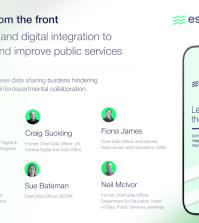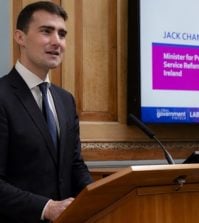Money talks – but does it listen? How government finance departments can help unlock digital transformation

Finance leaders have much to gain from digital technologies. But at the Global Government Finance Summit, they were told they also have something to give – reforming finance systems to ease the process of transformation. Matt Ross hears a clash of cultures
In today’s world, every organisational change or new public service has at its heart the use of digital technologies. That is as true in finance as every other field; so finance leaders need a good grasp of the potential and characteristics of digital technologies. But there’s another reason for improving finance professionals’ understanding and management of digital: in many countries, they control cross-government systems and processes – such as those governing procurement, budgeting and wage settlements – that have a major impact on the success of digital programmes.
Kevin Cunnington, a former director general of the UK’s Government Digital Service (GDS), recently interviewed the digital leaders of seven nations – producing a report on what digital leaders need to succeed in government. In Estonia in June, he presented his findings to senior leaders from treasuries and finance departments around the world at the Global Government Finance Summit (GGFS), contending that traditional approaches to financing and project management are impeding digital transformation. But his arguments were not, it is fair to say, universally welcomed.
First, Cunnington warned that some governments have taken their foot off the throttle on digital investment. “We’ve only just started replacing the legacy, building new systems,” he said. “We’ve got to get over this mentality in treasuries that says we’ve spent once and that’s enough, because this is a continual spend going forward for at least the next 25 years.”
Second, transformational projects typically involve the creation of cross-departmental systems and services – but Cunnington noted that “there is no consistent funding model that we saw, anywhere in the world, that enables treasures to allocate money to programmes of work that cover multiple departments”. New budgeting systems are required, he said, enabling public bodies to share ownership of interdepartmental projects: “Who’s accountable? How’s the money spent? What are the safeguards and controls?”
Third, Cunnington argued that civil service pay controls are hampering the recruitment and retention of senior digital staff, whose skills can attract much bigger salaries in the private sector. “There’s a quote in the report: ‘We pay very competitively for junior staff and competitively enough to get a fair number of mid-level staff. But we’re absolutely not competitive when it comes to the most senior staff, who are the people we need most’.”
Unable to fill key posts, he explained, civil service bodies often employ interims – but these lack “the authority, the mandate or the longevity” to pursue the changes required. Alternatively, departments over-promote in-house staff, who “make mistakes as part of the learning process. And that costs so much more than it would to fill the salary gap”.
Failing to offer senior technology specialists competitive salaries is “one of the biggest, fundamental mistakes that governments make,” he concluded. “And it’s a false economy: you save a few tens of thousands by paying less, but the mistakes that result cost you tens of millions”.
A smarter customer
Another major challenge, said Cunnington, lies in addressing the tension between governments’ project management, funding and procurement processes, and the best methodologies for designing and implementing digital systems.
Finance departments, he commented, “tend to regard digital transformation like they do building bridges or railways: we put a five-year plan together and make it happen”. But the vast majority of digital projects are about changing citizens’ behaviour – and it’s difficult to predict people’s responses to a new service. As a result, he explained, it’s often best to build new digital services using ‘agile’ project methodologies: “We try something, and see if it works. If it doesn’t, we’ll backtrack or move forward with something else.”
This experimental, iterative approach sits awkwardly with civil service spending approval systems, which tend to require project managers to specify in advance exactly how a system will operate. “Procurement programmes ask you to do a big request for a proposal; produce some criteria for assessment; do assessments; and then, three or six months later, you come up with a winner. That simply doesn’t work with agile at all,” he said. Instead, finance departments should approve chunks of development spending and “expect the plan to change as we move forward, because we need to change citizens’ behaviour and this is, in and of itself, unpredictable”.
Upcoming webinar: The root to all reform: how public finance can help unlock the government of the future
Market forces
Governments can help to address the problem by creating digital marketplaces, Cunnington argued. By pre-approving suppliers and pooling departments’ purchasing requirements, these can cut costs for both vendors and buyers – making it cost-effective for small businesses to sell to government. “Ten years ago, the UK spent £16bn [US$18.7bn] a year on technology with less than ten big suppliers,” he said. Thanks to its digital marketplace, “we now spend £7bn [US$8.2bn] on technology across over 2,000 suppliers, most of whom are UK SMEs”.
Valentina Ion, Microsoft’s director of business strategy for public finance, had also seen a “philosophy shift in terms of technology choices. In the past, we were looking at out-of-the-box solutions”. These days, digitally-advanced governments prefer to transition to Cloud-native systems and build up their own services from individual tools. There’s a “need for agile development of micro services,” said Ion. “From the moment you invest in a massive system, it takes three to five years to implement it; by that time, the technology is already outdated”.

However, Cunnington’s arguments received a chillier reception from the finance leaders – some of whom seemed to discount his concerns about civil service procurement processes. “Governments’ ways to purchase services and products are cumbersome, but it’s not a real issue,” said one, conceding that tight rules may “cause some extra harm” but maintaining that “it’s quite reasonable to think beforehand about what you’re trying to do. That’s not a hindrance; it’s just normal planning”.
Another accepted that rigid systems may lead project managers to “lose time; there may be extra costs”, but added that “with some difficulty, you can still bend [the system] to make it possible”. Only one argued that “finance departments should exercise flexibility in terms of procedures”, focusing on the issues around “how we retain talent; how we pay people”.
The holy grail of digital
Clearly, finance leaders are not all convinced of the need to adapt systems around the needs of digital technologies. But their digital peers will keep raising this agenda: Cunnington’s research is clear that the status quo is hampering progress – and there are huge opportunities if governments can start to realise the full potential of digital technologies.
When countries fully digitalise public services, they can link up data from “all the stakeholders in close to real time, gathering all the information that you need to be predictive and proactive in terms of government intervention,” commented Valentina Ion. The ability to “build a 360-degree view of the individual or company” enables governments both to personalise services around people’s needs, and to improve efficiency: given that holistic view, she explained, “the redundancy, the leakages within the system, the duplicate payments will be spotted and removed”.
Few civil services have reached this point. The UK, explained Kevin Cunnington, is “fundamentally stuck trying to reconcile all these silos of data that we have across the public sector universe”. When GDS counted the number of central government online services in 2016, he recalled, “we had 800 – none of which we could map together. So if you interacted with all those services, you inputted your data 800 times. That’s how bad it is for large governments with legacy services”.
Hence one of the key findings of Cunnington’s digital leaders report: that “digital identity is the holy grail; it’s the great divide” between those countries making rapid progress, and those stuck in a pre-digital world. To realise many of the benefits of digital, governments must be able to share data between departments, while citizens need easy access to a wide range of services via a single interface; none of this is possible without a single common digital ID system, enabling departments to confidently identify individuals and align services around them. The task of creating this system, Cunnington noted, is much easier if countries can build it around an existing national ID system, providing a shared way to identify individuals reaching across the public sector.
Winning public support

Governments seeking to digitalise services and share data between public bodies often find the public reluctant, with many concerned about security, privacy and ethical issues. These fears are best addressed in two ways, commented Raoul Lättemäe, head of the Fiscal Policy Department in the Ministry of Finance of Estonia – named by Ion as one of the world’s few mature digital nations.
First, governments must ensure that digitalisation generates clear benefits for citizens. In Estonia, he noted, “99% of the tax declarations of private individuals are conducted electronically”: automatically pulling in the required information and prefilling forms, the service radically reduces the workload for taxpayers.
Second, they must address people’s fears that data may be lost or stolen. Estonia, regularly threatened by its huge neighbour Russia, has prioritised cybersecurity in its digital infrastructure. “The security of our systems is relatively high; there haven’t been any serious hacks,” commented Evelyn Liivamägi, deputy secretary general for financial and tax policy at the Ministry of Finance.

The country also ensures that individuals control how their data is used and shared across government, informing them every time their information is accessed by a public servant. “Transparency drives trust, and trust definitely drives compliance,” commented Ion. The data architecture is relevant too, noted Lättemäe: “If it’s been explained that this is not a super-database, but different databases connected in a way that ensures privacy, and if you show the benefits of this digitalisation, then you don’t get opposition.”
And these improvements to data management have benefits for economic policymaking and public budgeting, as well as the quality and costs of service delivery. “Once we get this trusted and secure data collaboration within the ecosystem, much more potential is unlocked,” commented Ion. Given an accurate, up to date view of spending and public service delivery across government, “we can go into dynamic reallocation and adjustment of budgets. We can see in close to real time the evolution of the economy; the trends at the national and international levels. We can simulate the impact of policy changes, using technologies such as artificial intelligence”.
Fine words are not enough
To realise these opportunities, most governments will need to make big changes to their data management practices, digital capabilities and technology infrastructures. These are set out in digital strategies – and Cunnington argued strongly that these must include detailed implementation plans, covering the required funding, responsibilities, powers and accountabilities.
One digital leader, he noted, complained that his own country’s digital vision contained “nothing objectionable, and nothing actionable. And it is true that these things tend to state your ambitions, but they don’t tell you how to get there”. Effective strategies, Cunnington argued, clearly allocate accountability for delivery: departments can, for example, agree progress targets and metrics with central digital leaders, with the results feeding into organisational leaders’ performance appraisals.
As to what exactly is delivered – here, “the answer varies according to what constitution, what culture, what politics and what legacy you have,” he added. “There isn’t a single answer for all of us”. But all governments need to make strong progress on digital transformation. And that, in Kevin Cunnington’s view, requires a clear strategy, a detailed implementation plan, and action by finance leaders to reform how governments manage and fund transformation programmes.
This is our third report on the 2022 Government Finance Summit, which was held in Tallinn, Estonia in June. While the Summit is held in private, some participants have allowed us to publish their comments.
The first report covered an analysis of today’s inflationary pressures by John McCarthy, chief economist of Ireland’s Department of Finance; the second considered finance departments’ responses to the pandemic; and the fourth considered finance leaders’ evolving roles in policymaking. The final report looks at the role finance ministries can support environmental sustainability.























